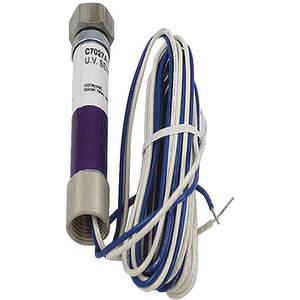Honeywell C7027A1049 UV flame sensor is used to detect the intensity of ultraviolet radiations. It is suitable for flame safeguard controls with ultraviolet amplifiers for supervising gas, oil & gas-oil burner operations.
Features:
- This sensor has an attached collar that facilitates mounting on a 1/2-inch sighting pipe and blast tube.
- This flame detector can be wired in parallel configuration for tough flame sighting installations.
- It comes with a 1/2 inch spud connection to provide secure electrical wiring.
- This sensor can be operated at temperatures ranging from -40 to 215 degrees F.
Standards and Approvals:
- CSA
- Underwriters Laboratories Inc.
Frequently Asked Questions:
Q. What is the difference between IR and UV flame detectors?
A. IR sensors monitor the infrared emission spectral band between 4.3 and 4.4 microns, which is the major radiant emission band for fires fueled by hydrocarbons. UV sensors detect flames produced by UV light.
Q. How do you test a UV flame sensor?
A.
- Point at the flame detector, which should be situated both within the test range and on the detector's centre axis.
- Wait until the flame detector turns On after pressing the switch.
- The switch should be intermittently actuated in a 1-second pulse for IR or UV/IR detectors (0.5 sec On, 0.5 sec Off).
Q. What safety precautions should I take when using this Honeywell C7027A1049 UV flame sensor?
A.
- Ensure proper installation according to manufacturer guidelines to prevent malfunction.
- Perform routine maintenance checks to keep the sensor clean and free from obstructions.
- Follow recommended calibration procedures for accurate flame detection.
- Provide a stable and appropriate power supply to prevent electrical hazards.
- Protect the sensor from extreme environmental conditions to maintain performance.
- Coordinate integration with other safety systems for effective operation.
- Provide training to personnel for safe handling and operation of the sensor.
Q. What are the factors to consider while choosing this Honeywell UV sensor?
A. Major factors include compatibility, detection range, sensitivity, environmental resilience, mounting options, integration compatibility, certification and maintenance needs.



